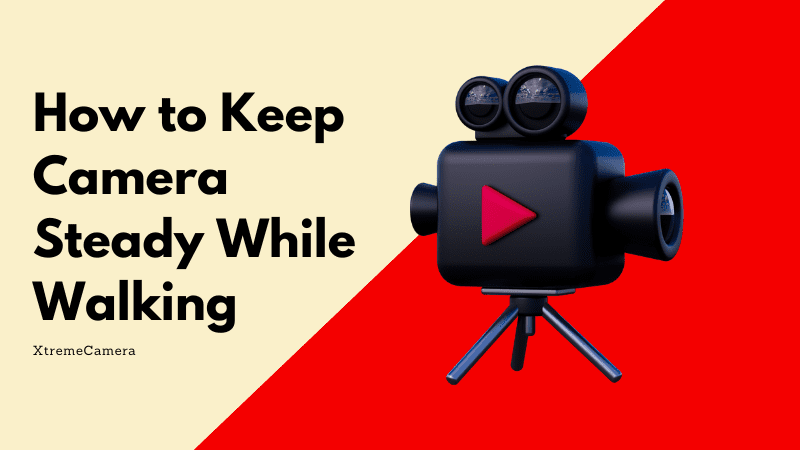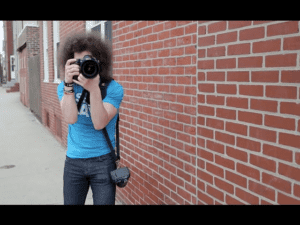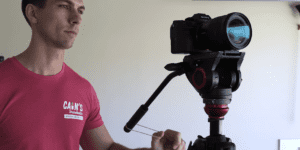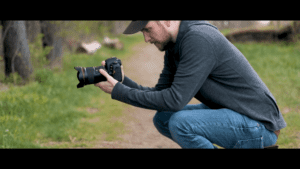Are you someone who loves to walk around while recording videos? This can actually be a little problematic for you as it only becomes more challenging to keep your footage stable. As a result, you get a wobbly feeling while looking at your videos, and your pictures turn out to be blurry.
Minimizing shaky videos is of utmost importance as it helps you get smooth footage and allows you to track objects efficiently. But you might wonder how to keep the camera steady while walking.
If you wish to stabilize your camera while walking, there are a number of ways you can do it. Before I walk you through these ways, it is essential to understand camera stabilization so that you can choose the most appropriate stabilization method for your camera.
Understanding camera stabilization
If buttery smooth footage is what you are trying to get, it is crucial to understand camera stabilization and pick the right technique to stabilize your camera while walking. Shaky pictures will completely ruin the results you were expecting, and you will be left with a blurry look that looks horrible.
By stabilizing your videos, you will not just have smooth footage but also an easier job at editing your videos. There are different types of camera stabilization methods that can be utilized to keep your camera steady while walking.
By utilizing a tripod, you will be able to do it effortlessly. Alternatively, you can also make use of a camera app or a stand that accompanies your device. Since a smartphone is likely to move and produce shaky results while you use it while walking, using a camera stabilizer can fix your problems easily.
Camera stabilizers come with a mount where you place your smartphone. You can find different types of camera stabilizers offering distinct features. You can also make use of handheld stabilization and proper grip technique to get the best results. To know about these different methods in detail, continue reading this guide.
How to Keep the camera steady while walking
Handheld stabilization
Even if you are planning to use stabilizer gears or other types of equipment, it would be best to make use of handheld stabilization along with them. Such techniques ensure that your footage remains blur-free and helps you avoid shaky results. Make sure to hold the camera properly, as it is the most crucial thing.
Use both hands
If you are a beginner who has no experience in handling a camera, begin by using both of your hands to hold your camera. Many times, we tend to get blurry pictures and wobbly videos when we use a single hand to operate the camera.
Furthermore, you should keep the camera close to your chest while you walk. This way, you will successfully eliminate shaking and get smooth footage.

Keep the camera closer
The balance of your camera is affected when you extend your arms away from your body. So it is best to keep them closer to your chest while walking and capturing. Another way to enhance the impact of this is to simply lock your arms while the camera remains close to your chest. This will definitely allow you to capture solid and blur-free videos as well as pictures.

Camera straps
Just by using and adjusting camera straps, you can successfully eliminate unnecessary movements of your camera that result in shaky or blurry results. It is one of the easiest methods for keeping your camera steady while you walk around and click pictures.
To adjust your camera straps in the best way possible, begin by attaching them to your camera if it’s not done already. Carefully place the camera strap towards the back of your neck. Now begin pulling your camera forward to tighten the strap, so it feels nice and tight. Once you do that, simply lock your arms and record videos in that particular position.

Body positioning
Appropriate body posture is necessary if you are looking to keep your camera steady while walking. Whether it is photography or videography, if you do not have a sufficient balance in your camera, you will always end up with blurry pictures and wobbly videos.
To have buttery smooth videos and pictures, positioning your body in the right manner is of utmost importance. You can do this by simply bending your knees a little while capturing. This will allow you to be in the most appropriate posture.
If nothing helps in avoiding unnecessary movements, consider leaning against a stable surface like a wall or tree. By supporting your back, you will be able to have a better posture that minimizes movement to stabilize video.

Proper grip technique
Proper grip technique is an excellent method for minimizing camera shake and getting a buttery smooth footage. If you own camcorders or DSLR cameras, you can simply hold it using its handgrip and try to keep it close to your body to stabilize footage.
On the other hand, if you work with a point-and-shoot camera, make sure to hold it with both of your hands for efficient support. While you stand, make sure to keep your feet a little apart while holding the camera. Similarly, draw your elbows into your body for the best results.
Breathing techniques
From muscle tension to unnecessary hand movements, there are a number of factors responsible for blurry pictures. To get rid of camera shakes and avoid shaky footage, there are a number of breathing techniques that you can inculcate.
You can start by practicing deep breathing, where you are supposed to inhale through your nose and take a deep breath followed by exhaling through your mouth. When your muscles feel relaxed, tension will reduce.
You can also click the picture while exhaling, as it tends to minimize camera shake. Inhale before clicking a picture and begin to exhale slowly while pressing the shutter. This will help you avoid sudden movements. You can even practice steady breathing by maintaining a stable rhythm while taking deep breaths. Once your breathing is stable, the frequency of random movements will automatically decrease, and you will get a steady video.
Since stabilizing your body will prevent camera shaking, there is another breathing technique to help you keep your body steady. You can simply begin by taking a slow and deep breath. After exhaling, you can hold your breath while you capture the picture to eliminate unnecessary movements.
Monopods and tripods
Although tripods and monopods are usually utilized for keeping your camera still, you can also use them to keep your camera steady while walking. You might wonder how it is possible.
Well, cameras are super light in weight. Due to their small size and lightweight, they become more prone to movements, especially when you are walking around with your camera. If you are able to add more weight to your camera, you can significantly bring down the number of small movements which are inevitably transferred from your body to the camera.
So if you are not willing to spend on a new fancy gear that is actually meant to stabilize your camera, you can simply utilize a tripod or a monopod. By fixing your camera to a tripod or a monopod, you can easily eliminate unnecessary movements.
This will be facilitated when you hold the tripod or the monopod in place of your camera while your camera remains attached to it. This method will effortlessly allow you to improve the stability of your camera even while walking.
Gimbal stabilization
Gimbals are one of the many camera stabilizers that you can use to eliminate shaking while you walk. They excel in capturing smooth shots which are well-controlled. If you want the best results and get buttery smooth shots and video footage, you can definitely invest in a gimbal.
All the other methods discussed in this guide before are simple to implement and very affordable. But if you are serious about the results and want to go ahead with the most effective methods, you can use an electronic camera gimbal.
Even while walking or moving, you will get smooth and blur-free results while using a gimbal, as it makes use of motors as well as sensors to keep your camera steady. By investing in a good quality gimbal, it won’t take you long to notice the differences in your videos and pictures while you get buttery-smooth results.

Additional tips for keeping the camera steady while walking
1. Slow and steady movements
Unnecessary movements are the main culprits of your camera shaking. Although most of such movements are sudden and inevitable, you can try to incorporate steady movements to have the best photography results.
To ensure that your camera does not shake, try to move as slowly as you can. Make sure that your movements are smooth enough to avoid random jerks that result in blurry pictures. Another way to eliminate camera shake is to simply utilize a low shutter speed while capturing a subject that is stationary.
For pictures that are much sharper, you can even make use of your camera’s image stabilization if that feature is available. Optical image stabilization allows you to capture things clearly with reduced camera shake.

2. Proper footwork
If you are able to maintain your body’s balance, you will be able to significantly reduce the level of camera shake. And to have a proper balance, you cannot overlook footwork, which is one of the most crucial aspects that help to keep your camera steady.
The most important tip you can utilize is to keep your feet apart, approximately shoulder-width. This particular posture allows you to maintain adequate balance. No matter the way you stand, your body weight should be evenly distributed between both of your feet.
This way, you would neither stumble nor have a poor balance. Some people tend to stand on their tip toes and shift their weight from one leg to another. Such habits create unnecessary movements which can easily be avoided. As discussed before, you can also keep your knees bent down a little for a better posture, which eventually eliminates camera shake.
3. Practicing and training
You can try a lot of techniques for eliminating unwanted movement and camera shake and shaky footage, but the only way you will actually be able to master it is by consistent practice and training. The first thing you need to practice is the way you hold your camera.
The only way you can discover the most comfortable method of holding your camera is by practicing and experimenting with different positions. You can try various grips and eventually stick to the one that feels the most comfortable.
By regularly practicing the breathing techniques mentioned earlier in this guide, you will definitely notice some improvement. Make sure to also experiment with different body postures and shooting positions to find out the most comfortable one for yourself. You can stand or even kneel down.
Exercising regularly can further release muscle tension and boost your stability and balance while shooting video. But as much as physical strength, you have to prioritize your mental focus as well. With proper concentration, you will automatically have improved stability.

Conclusion
Keeping your camera steady is essential while filming, especially if you prefer walking around. There are different methods that you can utilize for camera stabilization. If you are not willing to invest directly in stabilizers and some other fancy gear, start by using simple techniques like handheld stabilization, correcting your body posture, practicing breathing techniques, and making use of the proper grip technique.
You can invest in a tripod or monopod for higher efficiency. The most effective way of keeping your camera steady while walking is definitely gimbal stabilization. With proper practice and training that comes from consistently experimenting with different techniques to prevent camera shake, your stability, and balance will eventually improve.





